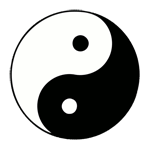 |
| Yin-Yang |
Significance of Yin-Yang symbol
The charming Yin-Yang symbol, which has become a popular New Age icon, contains many levels of meaning. The more we study it, the more meaning we find. The Yin-Yang symbol is dualistic. The white tadpole yang represents the bright, active, male principle. The black one, yin represents the dark, passive, female principle. Put them together and their interaction produces our phenomenal universe.
Characteristics of Yin-Yang Symbol
Now, the interesting thing about the two tadpoles is that each contains an eye that is the color of its opposite. The eye can be thought as a seed. This means that each contains the seed of the other; each has the potential to morph into its opposite. So light can become darkness, darkness can become light; activity can become passive, passivity can become active; the male can become feminine, the female can become masculine. Neither tadpole is an absolute, both are relative and they are constantly interacting.
Yin-Yang - a symbol of Tao
The Yin-Yang icon is an ideal symbol for the phenomenal world of interacting, ever-changing relativities. For that reason, in Vedantic terms, it might easily be taken as a symbol of maya. But in Taoism it is usually considered to be symbol of the Tao, the ultimate reality in Taoist philosophy.
The Tao (pronounced Dow and meaning literally a road or a way) has much in common with Brahman, the ultimate reality in Vedanta. The first chapter of the primary Taoist text, The Tao-te-Ching, describes it as the origin of heaven and earth.
Tao (The Way) that can be spoken of is not the Constant Tao’Chapter four calls it a preface to God.
The name that can be named is not a Constant Name.
Nameless, is the origin of Heaven and Earth;
The named is the Mother of all things.
Thus, the constant void enables one to observe the true essence.
The constant being enables one to see the outward manifestations.
These two come paired from the same origin.
But when the essence is manifested, It has a different name.
This same origin is called “The Profound Mystery.”
As profound the mystery as It can be,
It is the Gate to the essence of all life.
Tao (The Way) can be infused into the nature and put to use without being exhausted.For Taoists, it functions much like an absolute.
It is so deep and subtle like an abyss that is the origin of all things.
It is complete and perfect as a wholeness that can
Round off sharp edges;
Resolve confusion;
Harmonize with the glory;
Act in unity with the lowliness.
Tao is so profound and yet in invisible, It exists in everywhere and anywhere.
I don not know whose Son It is, It existed before heaven and earth.
Natural Order of Things
The Tao may sound a lot like Brahman, but there are some differences in emphasis. The Tao is mysterious; it has a nurturing aspect; its immanence is stressed more than its transcendence; it is strongly identified with nature and the natural order of things. The Taoist aspirant is not urged to realize the Tao, as the Vedantist is urged to realize Brahman. His goal is more modest: to lead a simple, natural life to attune himself with the Tao, to blend in with it and try to reflect its nature.
Conclusion
In contrary to the Vedantic view a question arises
Where is Brahman in all this?When all of this is very fine. The Yin-Yang symbol may be intended to represent an absolute, but in fact it is dualistic and does a better job of representing maya.
To answer this question, we have to step back and view everything from a much broader perspective. Then we will see that
Brahman is not the Yin;
Brahman is not the Yang;
Brahman is not the Yin and Yang in combination.
Brahman is the background.
A beautiful video, by John Bellaimey , explains the hidden meaning of Yin and Yang.
Related Articles on Ancient Chinese Wisdom
 |
The Wisdom of Wei Wu Wei a Secret Art of Non-Doing |
 |
A Journey of a Thousand Miles Begins With a Single Step - #Beleive |
 |
How Can We Achieve A Balance Our Negative and Positive Energies - Yin and Yang |
 |
How The Movie Rock On and it's Sequel encompass the essence of Taoist Philosophy |










